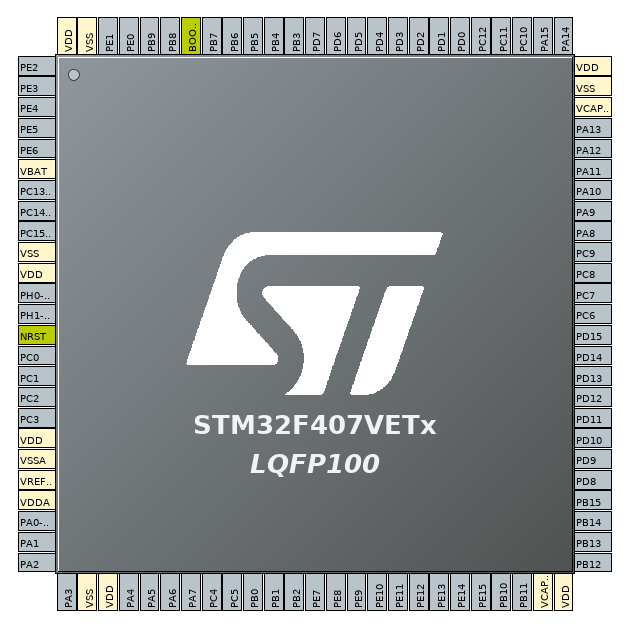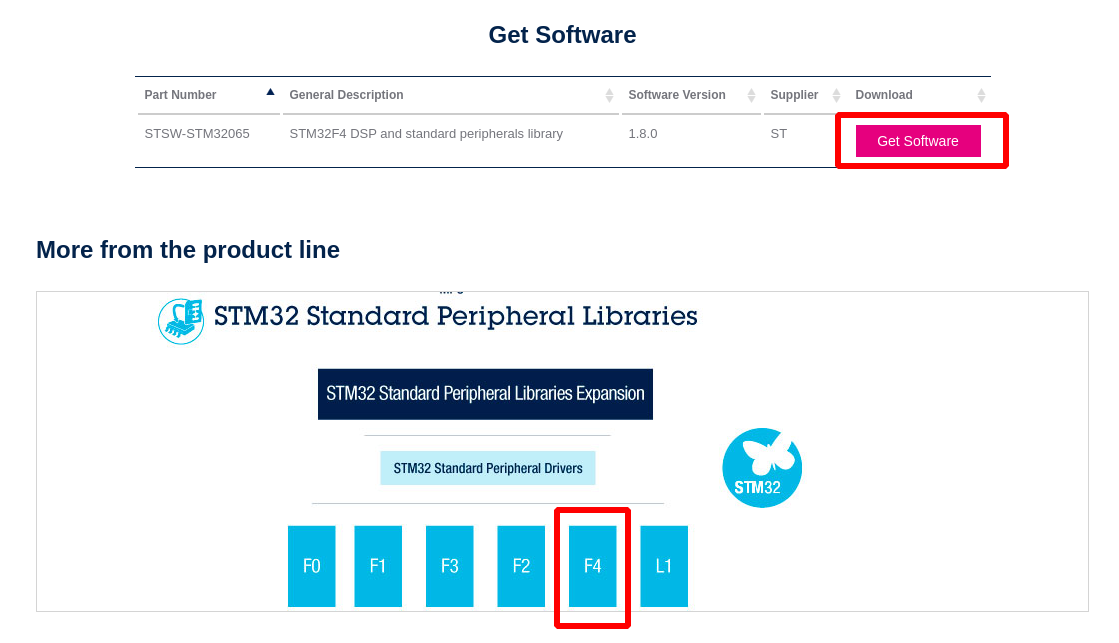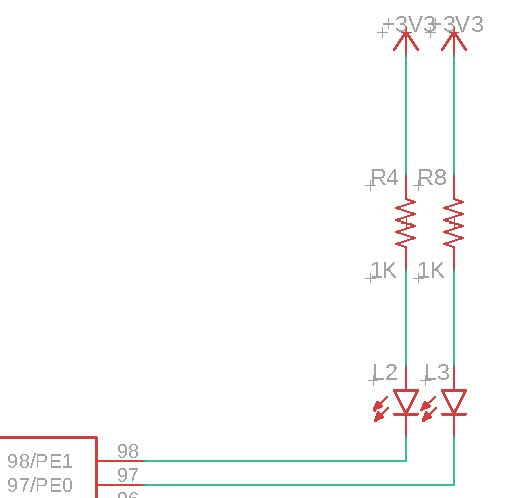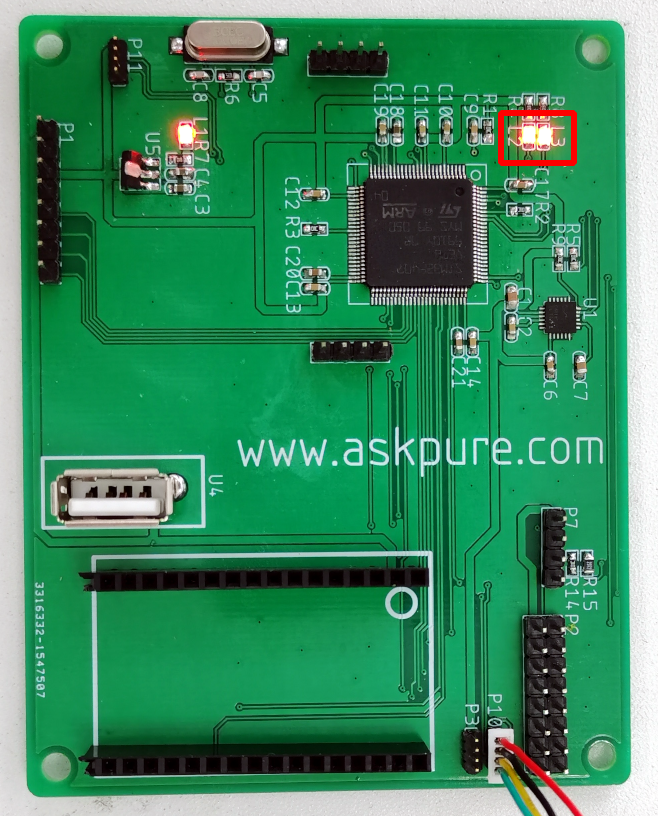从晶元到人工智能
我们在控制模块中所使用的处理器是Cortex-M4系列中的STM32F407VE,这个处理器芯片有100个引脚,其中包含一些电源供电引脚、外部晶振引脚、SWD程序烧录引脚和我们最常用的GPIO功能引脚:

实际上,我们使用的GPIO并不多,我们只使用了3路AD采集、Uart1和Uart2、I2C1、Tim3和Tim4的PWM输出引脚以及几个普通GPIO脚(具体使用情况请参照《控制模块》)。STM32中有丰富的硬件资源供我们使用,例如:AD采集、串口、I2C、SPI、SDIO、CAN、USB_OTG_FS、USB_OTG_HS、I2S、PWM输出、PWM采集、GPIO输入输出等。在这一节里我们将完成STM32的第一个小程序:点亮LED灯。
一、开发环境搭建:
我们的整个项目都会在Linux系统下完成,因此后续所有章节中如无特殊说明,我们都默认在Linux下搭建所有的开发环境。
首先,我们需要下载并安装在Arm平台下的gcc编译工具arm-none-eabi-gcc。作者所使用的Linux发行版为Arch-Linux,可以直接使用下面命令进行安装:
#Arch-Linux
pacman -S arm-none-eabi-gcc
#Fedora
yum install arm-none-eabi-gcc
#ubuntu
apt-get install arm-none-eabi-gcc
一般来说,其它Linux的发行版都有着自己的安装软件包的方式,我们不再一一列举。此外,我们还可以直接在GNU的网站上直接下载压缩包:
我们下载Linux x86_64 Tarball压缩包,解压到指定目录,并将其目录加入到PATH环境变量中,最后执行以下命令的查看是否安装成功:
$ arm-none-eabi-gcc --version
arm-none-eabi-gcc (GNU Tools for ARM Embedded Processors) 5.4.1 20160919 (release) [ARM/embedded-5-branch revision 240496]
Copyright (C) 2015 Free Software Foundation, Inc.
This is free software; see the source for copying conditions. There is NO
warranty; not even for MERCHANTABILITY or FITNESS FOR A PARTICULAR PURPOSE.
其次,我们还需要使用STM32F4xx的标准开发库,我们可以到STM32官方的网站上下载:

我们需要下载F4系列的标准开发库,下载并解压之后,得到以下目录:
├── CMSIS
│ ├── Device
│ └── Include
└── STM32F4xx_StdPeriph_Driver
├── inc
└── src
这样我们的开发环境就准备好了,接下来就可以在这个开发不环境下进行开发了。
二、点亮LED灯:
使用arm gcc来编译STM32所运行的程序,我们需要编写一个Makefile如下:
# Output files
ELF_FILE = led.elf
BIN_FILE = led.bin
HEX_FILE = led.hex
INFO_FILE = led.info
CODE_FILE = led.code
#------------------------------------------------------------------------#
# Cross Compiler
CC = arm-none-eabi-gcc
OBJCOPY = arm-none-eabi-objcopy
OBJDUMP = arm-none-eabi-objdump
READELF = arm-none-eabi-readelf
#------------------------------------------------------------------------#
# Flags
CFLAGS += -std=gnu11
CFLAGS += -mthumb
CFLAGS += -Wno-incompatible-pointer-types
CFLAGS += -Wno-unused-but-set-variable
CFLAGS += -Wno-unused-variable
CFLAGS += -mcpu=cortex-m4
CFLAGS += -mfpu=fpv4-sp-d16 -mfloat-abi=hard
CFLAGS += -D"assert_param(expr)=((void)0)"
CFLAGS += -D STM32F40XX -DUSE_STDPERIPH_DRIVER
CFLAGS += -nostartfiles
#------------------------------------------------------------------------#
# Link script
CFLAGS += -Wl,-Tled.ld
#------------------------------------------------------------------------#
# Libraries
STM32_LIBS = libs/STM32F4xx_StdPeriph_Driver
CFLAGS += -I$(STM32_LIBS)/inc
CFLAGS += -Ilibs/CMSIS/Include
CFLAGS += -Ilibs/CMSIS/Device/ST/STM32F4xx/Include
#------------------------------------------------------------------------#
# Src Path
SRCS = ./src
CFLAGS += -I$(SRCS)
CFLAGS += -I./inc
#------------------------------------------------------------------------#
# Main Board
SRC += $(SRCS)/main.c
#------------------------------------------------------------------------#
# System
SRC += ./src/system_stm32f4xx.c
STARTUP = ./src/startup_stm32f40xx.s
#------------------------------------------------------------------------#
# StdPeriph
SRC += $(STM32_LIBS)/src/misc.c \
$(STM32_LIBS)/src/stm32f4xx_rcc.c \
$(STM32_LIBS)/src/stm32f4xx_gpio.c
STARTUP_OBJ = startup_stm32f40xx.o
all:$(BIN_FILE) $(HEX_FILE) $(INFO_FILE) $(CODE_FILE)
$(BIN_FILE):$(ELF_FILE)
$(OBJCOPY) -O binary $^ $@
$(HEX_FILE):$(ELF_FILE)
$(OBJCOPY) -O ihex $^ $@
$(INFO_FILE):$(ELF_FILE)
$(READELF) -a $^ > $@
$(CODE_FILE):$(ELF_FILE)
$(OBJDUMP) -S $^ > $@
$(STARTUP_OBJ):$(STARTUP)
$(CC) $(CFLAGS) $^ -c $(STARTUP)
$(ELF_FILE):$(SRC) $(STARTUP_OBJ)
$(CC) $(CFLAGS) $^ -o $@
之后,我们还需要编写一个led.ld的链接脚本,内容如下:
/* Entry Point */
ENTRY(Reset_Handler)
/* Highest address of the user mode stack */
_estack = 0x20020000; /* end of 128K RAM on AHB bus*/
/* Generate a link error if heap and stack don't fit into RAM */
_Min_Heap_Size = 0; /* required amount of heap */
_Min_Stack_Size = 0x400; /* required amount of stack */
/* Specify the memory areas */
MEMORY
{
FLASH (rx) : ORIGIN = 0x08000000, LENGTH = 512K
RAM (xrw) : ORIGIN = 0x20000000, LENGTH = 128K
CCMRAM (rw) : ORIGIN = 0x10000000, LENGTH = 64K
}
/* Define output sections */
SECTIONS
{
.myBufBlock 0x10000000 :
{
KEEP(*(.myBufSection)) /* keep my variable even if not referenced */
} > CCMRAM
/* The startup code goes first into FLASH */
.isr_vector :
{
. = ALIGN(4);
KEEP(*(.isr_vector)) /* Startup code */
. = ALIGN(4);
} >FLASH
/* The program code and other data goes into FLASH */
.text :
{
. = ALIGN(4);
*(.text) /* .text sections (code) */
*(.text*) /* .text* sections (code) */
*(.rodata) /* .rodata sections (constants, strings, etc.) */
*(.rodata*) /* .rodata* sections (constants, strings, etc.) */
*(.glue_7) /* glue arm to thumb code */
*(.glue_7t) /* glue thumb to arm code */
*(.eh_frame)
KEEP (*(.init))
KEEP (*(.fini))
. = ALIGN(4);
_etext = .; /* define a global symbols at end of code */
_exit = .;
} >FLASH
.ARM.extab : { *(.ARM.extab* .gnu.linkonce.armextab.*) } >FLASH
.ARM : {
__exidx_start = .;
*(.ARM.exidx*)
__exidx_end = .;
} >FLASH
.preinit_array :
{
PROVIDE_HIDDEN (__preinit_array_start = .);
KEEP (*(.preinit_array*))
PROVIDE_HIDDEN (__preinit_array_end = .);
} >FLASH
.init_array :
{
PROVIDE_HIDDEN (__init_array_start = .);
KEEP (*(SORT(.init_array.*)))
KEEP (*(.init_array*))
PROVIDE_HIDDEN (__init_array_end = .);
} >FLASH
.fini_array :
{
PROVIDE_HIDDEN (__fini_array_start = .);
KEEP (*(.fini_array*))
KEEP (*(SORT(.fini_array.*)))
PROVIDE_HIDDEN (__fini_array_end = .);
} >FLASH
/* used by the startup to initialize data */
_sidata = .;
/* Initialized data sections goes into RAM, load LMA copy after code */
.data : AT ( _sidata )
{
. = ALIGN(4);
_sdata = .; /* create a global symbol at data start */
*(.data) /* .data sections */
*(.data*) /* .data* sections */
. = ALIGN(4);
_edata = .; /* define a global symbol at data end */
} >RAM
/* Uninitialized data section */
. = ALIGN(4);
.bss :
{
/* This is used by the startup in order to initialize the .bss secion */
_sbss = .; /* define a global symbol at bss start */
__bss_start__ = _sbss;
*(.bss)
*(.bss*)
*(COMMON)
. = ALIGN(4);
_ebss = .; /* define a global symbol at bss end */
__bss_end__ = _ebss;
} >RAM
/* User_heap_stack section, used to check that there is enough RAM left */
._user_heap_stack :
{
. = ALIGN(4);
PROVIDE ( end = . );
PROVIDE ( _end = . );
. = . + _Min_Heap_Size;
. = . + _Min_Stack_Size;
. = ALIGN(4);
} >RAM
/* Remove information from the standard libraries */
/DISCARD/ :
{
libc.a ( * )
libm.a ( * )
libgcc.a ( * )
}
.ARM.attributes 0 : { *(.ARM.attributes) }
}
最后,我们编写程序源代码文件main.c,实现LED亮灯功能:
#include <stm32f4xx.h> #include <stm32f4xx_conf.h> int main(int argc, char* argv[]) { GPIO_InitTypeDef GPIO_InitStructure = { 0 }; RCC_AHB1PeriphClockCmd(RCC_AHB1Periph_GPIOE, ENABLE); GPIO_InitStructure.GPIO_Mode = GPIO_Mode_OUT; GPIO_InitStructure.GPIO_Pin = GPIO_Pin_0 | GPIO_Pin_1; GPIO_InitStructure.GPIO_Speed = GPIO_Speed_50MHz; GPIO_Init(GPIOE, &GPIO_InitStructure); GPIO_WriteBit(GPIOE, GPIO_Pin_0, 0); GPIO_WriteBit(GPIOE, GPIO_Pin_1, 0); while (1) { } }
需要说明的是,我们先来看一下LED电路的原理图:

可以看到两个LED分别使用的是PE0和PE1引脚,当引脚为低电平时LED灯亮起,当引脚为高电平时LED熄灭,因此,当我们希望LED亮起只需要通过GPIO_WriteBit()函数将PE0和PE1拉低即可。

点亮了两个LED之后,我们还可以将源代码修改一下,让LED变为闪烁状态:
#include <stm32f4xx.h> #include <stm32f4xx_conf.h> int main(int argc, char* argv[]) { GPIO_InitTypeDef GPIO_InitStructure = { 0 }; RCC_AHB1PeriphClockCmd(RCC_AHB1Periph_GPIOE, ENABLE); GPIO_InitStructure.GPIO_Mode = GPIO_Mode_OUT; GPIO_InitStructure.GPIO_Pin = GPIO_Pin_0 | GPIO_Pin_1; GPIO_InitStructure.GPIO_Speed = GPIO_Speed_50MHz; GPIO_Init(GPIOE, &GPIO_InitStructure); while (1) { GPIO_WriteBit(GPIOE, GPIO_Pin_0, 1); GPIO_WriteBit(GPIOE, GPIO_Pin_1, 0); for (int i = 0; i < 1000000; i++) { } GPIO_WriteBit(GPIOE, GPIO_Pin_0, 0); GPIO_WriteBit(GPIOE, GPIO_Pin_1, 1); for (int i = 0; i < 1000000; i++) { } } }
我们在while循环中加入两个for循环让处理器执行100000次实现程序“等待一小会儿”的功能,但实际上这段时间处理器还是在运行的,我们来看一下效果:
Copyright © 2015-2023 问渠网 辽ICP备15013245号